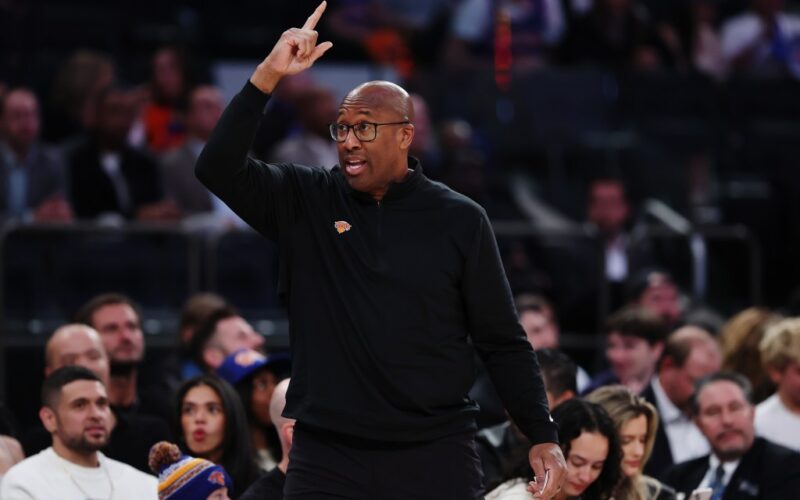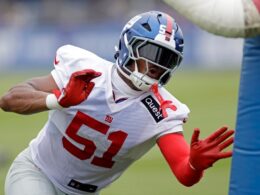With 4:15 remaining in the fourth quarter of the Knicks’ preseason finale against the Charlotte Hornets on Friday, Mike Brown did his best Tom Thibodeau impression.
He subbed Mikal Bridges back into a game that was already decided.
The Knicks, playing without four key rotation players, led Charlotte, 111-97 — a comfortable margin, but not enough for Brown to abandon his preseason plan. From the far end of the bench, he waved in No. 25, who made long, deliberate strides toward the scorer’s table at midcourt.
Jalen Brunson was already directing traffic, and together the two available starters closed out the final minutes — and the preseason.
The absences were notable: Karl-Anthony Towns, Mitchell Robinson, OG Anunoby, and Josh Hart all sat the final exhibition game, the last tune-up opportunity before the games begin to count on opening night against the Cleveland Cavaliers on Oct. 22.
But for those who suited up, Friday night was a controlled rehearsal, a crash course in Mike Brown basketball.
“This is the best type of experience you can get,” said Brunson, who scored 15 points in the first quarter and finished with 31 points, seven rebounds and six assists in the finale. “You can do all the stuff in practice you want, but as much as you’re trying to simulate it, it’s not game reps. Game reps are always important.”
Brown is installing new philosophies on both ends of the floor — a faster, freer, more aggressive system designed to stretch the Knicks’ identity and, he hopes, their ceiling.
The foundation of a contender is there. The polish is still a work in progress.
“Whether we had everyone or not, this is a marathon, not a sprint. You hope to be sharp by opening night, but the goal is to keep moving forward.”
***
Perhaps last season was an anomaly.
The Knicks were the healthiest team in the NBA in 2024–25 — first in both games and minutes lost to injury, according to league tracking data. Much of that success was attributed to Casey Smith, the team’s vice president of sports medicine who joined New York last year after nearly two decades with the Dallas Mavericks.
Fast forward one summer, and the script has flipped.
Anunoby missed the preseason opener in Abu Dhabi with a sprained hand, then sat the finale with a tweaked ankle — both injuries suffered in practice. Hart began camp with a stint in his right ring finger, then suffered back spasms in the opener and has yet to be cleared for basketball activity. Towns was held out for precautionary reasons after battling a quad issue. And Robinson has been on a managed workload, last appearing for 13 minutes in the first half of the Oct. 9 win over the Minnesota Timberwolves.
When asked why his starting center hadn’t seen the floor in over a week, Brown offered a single-word answer — and a telling one.
“Uh, Casey,” he said with a smile. “And it’s above my head in terms of getting into the specifics with it.”
The math paints a clearer picture. Out of a possible 1,225 minutes across five preseason games (plus one overtime period against Minnesota), Robinson, Towns, Hart and Anunoby have combined for just 152. Hart alone has logged only seven total minutes, and from Oct. 2–18, he hasn’t been a full participant in practice.
That’s far from ideal for a team trying to absorb Brown’s playbook — a system built on speed, spacing and cohesion that requires real game reps to master.
“I would love to have everyone together, especially trying to play the way we’re playing with it being new to everybody,” Brown said. “But it is what it is. This thing is gonna be a marathon. It’s not a sprint.
“You’re always hoping you’re at your peak on opening night — but the guys that have been out are key pieces to what we’re trying to do. They haven’t gotten the reps, and for us to jell together from top to bottom is gonna take a little more time than I thought, probably because of the injuries.”
The Knicks have thrown ideals out the window. Anunoby and Robinson have checkered injury histories, and Towns is coming off a season marred by knee issues. It’s part of the reason Brown is re-imagining how this team plays — building a system designed to sustain success even when the stars aren’t on the floor.
“Any time you’re missing guys, it’s next guy step up — and knock on wood, we could be missing guys during the season,” Brown said. “So it’s just another opportunity for guys to step up and get a chance to play. We’ll go out and play the game with who’s available.”
***
Pace. Spacing. Paint touches. Quick decisions. Ball reversals.
Welcome to Mike Brown’s Knicks.
Brown’s offensive vision is built on movement — both of the ball and the bodies creating space around it. The idea is simple: force the defense to make choices, and punish whichever one it makes wrong.
It starts in transition, where the nearest non-center sprints to fill the corners and stretch the floor. From there, the ball-handler drives the paint, putting the defense in conflict — collapse to protect the rim, or stay home on shooters.
“If the defense doesn’t collapse, then we need to finish it [at the rim]. If it does collapse, we need to spray it,” said Brown. “And in my opinion, those spray threes off dribble-drives and just someone making a basket cut: Those types of threes are great threes.
“And I don’t care who’s open, when it hits your hands, let that thang fly.”
The early returns tell the story. New York attempted a whopping 222 threes across five preseason games — nearly 10 more per game than last season’s regular-season average under Thibodeau. Even so, the Knicks only ranked ninth leaguewide in preseason three-point attempts at 44.1 per game, with the Boston Celtics unsurprisingly leading the field at 47.
The difference isn’t volume for volume’s sake — it’s philosophy. Brown’s threes are built from inside out, created through “paint touches” that lead to what he calls “sprays.” His goal: 25 sprays a game.
“If you think about it, most guys, when they’re getting their work in, it’s a coach standing there, the player standing there, another coach rebounding and just passing the ball,” Brown said. “Catch-and-shoot threes — it’s the easiest threes.
“So we promote spacing. And if the floor is spaced the right way, we promote quick decisions — whether it’s a cut, a snap drive, or a roll. We want to touch the paint to collapse the defense.”
While the drive-and-kick philosophy isn’t entirely new, the way the Knicks get to the paint is. Under Thibodeau, much of the offense relied on individual creation — clear-outs for Brunson or Julius Randle to go to work in isolation while other became afterthoughts.
Isolation remains an option, particularly in crunch time, but Brown’s system is built to be greater than the sum of its parts.
“I think having a structure where everybody is clear and understands our triggers and what we’re trying to do,” said Landry Shamet, one of the holdovers from last year’s team. “Obviously, we have great playmakers — guys who are eventually going to be able to shine and do their thing. But the reality is, if one or a few of those guys aren’t on the floor, how do we collectively still be effective and even give other teams a different look?
“That’s what this kind of structure gives you — the opportunity to play with two different flavors. If we’re playing one way with the first unit, and the second unit comes in running strictly out of structure, that’s something opponents have to adjust to in a short amount of time. I think that’s beneficial.”
Brown believes this roster was built for speed — that the Knicks’ collective basketball IQ, shooting depth, and willingness to share the ball make them tailor-made for an up-tempo system. He sees pace, spacing, and selflessness not as stylistic preferences but as the blueprint for a deep playoff run — maybe even a trip to the Finals.
“[That] usually bodes well for them — at least that’s what I’ve experienced in my last three years, four if you include the Nigerian national team,” Brown said. “It’s not the same offense we ran in Golden State, but there are concepts we took from there and added to what we’re doing.
“At the same time, it takes some time to get used to playing this way. It’s not gonna happen all at once, and I think our guys know that — but they’re working their tails off to get there.”
The Knicks are behind schedule only in availability, not ambition. The new system will take time to sharpen, and that’s by design.
This season is a marathon, not a sprint — and the Knicks hope their best basketball comes when the games matter most.
“We weren’t gonna be a finished product by the end of preseason anyway,” said Brunson. “We’re gonna continue to get better. We’re not gonna be who we want to be yet — hopefully this is a long season.
“We’ve got a lot to do to be where we want to be. It’s gonna be a work in progress, but I like how we’re competing and how we’re playing.”








